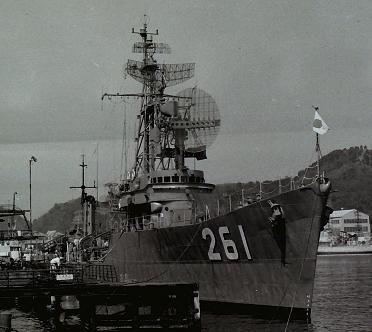Name JDS Wakaba Commissioned 15 March 1945 as Nashi Launched 17 January 1945 Weight 1,250 tons | Laid down 1 September 1944 Construction started 1 September 1944 Length 100 m Builder Kobe | |
 | ||
Fate Sunk, 28 July 1945
Salvaged, 1955 Recommissioned 31 May 1956, as JDS Wakaba Refit 1958 (weapons & radar)
1960 (sonar) | ||
JDS Wakaba was the former Imperial Japanese Navy ship Nashi, a Tachibana-class destroyer. Nashi was sunk in July 1945, but salvaged in 1954 and refitted to join the Japan Maritime Self-Defense Force in 1956 as Wakaba, later being utilised as a radar trials ship.
Contents
Design and description
The Tachibana sub-class was a simplified version of the preceding Matsu class to make them even more suited for mass production. The ships measured 100 meters (328 ft 1 in) overall, with a beam of 9.35 meters (30 ft 8 in) and a draft of 3.37 meters (11 ft 1 in). They displaced 1,309 metric tons (1,288 long tons) at standard load and 1,554 metric tons (1,529 long tons) at deep load.
The ships had two Kampon geared steam turbines, each driving one propeller shaft, using steam provided by two Kampon water-tube boilers. The turbines were rated at a total of 19,000 shaft horsepower (14,000 kW) for a designed speed of 28 knots (52 km/h; 32 mph). They had a range of 4,680 nautical miles (8,670 km; 5,390 mi) at a speed of 16 knots (30 km/h; 18 mph).
The main armament of the Tachibana sub-class consisted of three Type 89 127-millimeter (5.0 in) dual purpose guns in one twin-gun mount aft and one single mount forward of the superstructure. They carried a total of twenty-four Type 96 25-millimeter (1.0 in) anti-aircraft guns in four triple and a dozen single mounts. The ships were also armed with four 610-millimeter (24.0 in) torpedo tubes in a single quadruple traversing mount and 60 depth charges.
Construction and career
Nashi was launched by Kawasaki, Kobe, on 17 January 1945 and completed on 15 March. She was assigned to Desron 11, Combined Fleet, for training on 15 March 1945. In May 1945 she was assigned to Destroyer Division 52, Cruiser-Destroyer Squadron 31. Nashi escaped an attack on Kure harbour by B-29's on 22 June 1945, but on 28 July 1945 was sunk at Mitajirizaki, Kure (34°14′N 132°30′E) by aircraft from Halsey's Task Force 38. Commander Takeda and most of the crew survived. On 15 September 1945, Nashi was officially struck from the Navy list. The ship was refloated in 1954, and after repair at Kure recommissioned in the JMSDF as Wakaba on 31 May 1956. She was refitted in 1958 for use as a radar trials ship, and sonar was added in 1960. As such she was the only ship of the Imperial Japanese Navy to become part of the post-war Japan Maritime Self-Defense Force, and for some time was the biggest ship in the JMSDF.
Wakaba was struck on 31 March 1971, and scrapped in 1972-73. 'Nashi' is a type of pear. 'Wakaba' means "Young Leaves" in Japanese, suggesting the "green shoots" of recovery, a symbol of a new start after the war. And, in Japanese Hiragana, 'Nashi(なし)' means "Not exist", therefore to avoid misunderstanding "Not exist" she was renamed.
